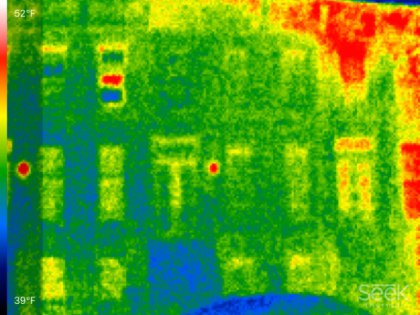Staying Warm and Cozy this Winter with a Passive House
2017.02.09

The weather has been very unpredictable this season. New York City has seen temperatures as high as 60°F one day, followed by a low of 26°F the next. This variation puts a lot of strain on typical heating systems, not to mention upending your wardrobe strategy.
A typical residential furnace is great at blasting away when the temperature drops, unfortunately it uses a tremendous amount of energy in the process. With leaky windows and little to no insulation in most walls, your resulting indoor air will be very dry, stale and irritating.
The way conventional thermostats work is to orchestrate a constant cycle of over- and then under-heating, which leads to rooms that are never quite at the right temperature. The furnace alternates between blasting heat and sitting idle as it strives to keep your home warm, and you’re forced to repeatedly put on and take off your sweater.
That’s one of the reasons we’re huge advocates for Passive House technology.
What is a Passive House?

A Passive House maintains a consistent, even temperature for maximum efficiency and comfort by combining airtight, well-insulated walls with constant fresh air ventilation and energy recovery.
What sets this approach apart from conventional buildings is the system is designed to maintain a steady balance between all components, rather than aggressively heating or cooling to make up for the failures of typical inefficient construction.
The air quality it extremely high since fresh air is constantly being circulated into the house, but it is pre-warmed using the energy from the exhaust ventilation, resulting in a greatly reduced need for additional heating.
The Benefits of a Passive House
1. Consistent indoor temperature, from top to bottom.
With a Passive House your home maintains a consistent air temperature on all floors, whether it’s 40°F or 14°F outside. Using an airtight, well-insulated roof and walls, the house remains warm using a minimum of energy. And unlike a conventional house, the heating system is quiet and predictable, meaning your heating bills stay consistently low.
2. Warm surfaces = A happy home.
Successfully keeping the inside air isolated from exterior temperatures is the secret to good insulation. In order to do this, conventional home construction uses 4” thick, batt insulation made of fiberglass. This is better than nothing, but we always support more sustainable material options, which is why we frequently use cellulose insulation in our Passive House projects. Cellulose insulation is made from 85% recycled paper. It’s low thermal conductivity and spray application makes it an ideal resource for sustainably insulating your home.
Insulation is usually the oldest part of any building due to its inaccessibility after construction is finished; it’s easier to replace a standard mechanical system than it is to fully renovate and update insulation. But by retaining this outdated solution, central air or radiator systems are rendered barely sufficient at warming the inside of a house. Usually, walls and floors in such homes will stay cold to the touch no matter how much warm air is blasting through.
3. No drafts.
In a Passive House proper insulation and airtightness eliminates drafts and consequently floors, countertops, walls and windows all remain at ambient temperature and are not uncomfortably cold to the touch.
4. Fresh air circulates throughout the whole house, even in winter.
With a strong focus on airtightness and insulation to maintain warmth, you may think that accessing fresh air would be a problem for a Passive House. In fact, it’s quite the opposite. A dedicated intake vent is always drawing in fresh air, which is filtered and warmed using the heat from the exhaust air before being introduced into the house.
So even in winter you can enjoy the same amount of fresh air as you would in summer with all the windows open. This is a huge difference from the majority of other heating systems, which generally just recirculate the same stale air, and struggle to process fresh air due to its initial low temperature. Most of these systems rely on the cracks and gaps in walls and around windows to keep some air moving from the outside in.
5. Windows are an asset, not a liability.
It’s a misconception that windows are inherently cold and drafty and therefore should be small to avoid heat loss. With a Passive House, that’s simply not true. Passive House systems utilize windows to their best advantage.
Sunlight has a tremendous warming effect on a building, “passively” transmitting energy without the need to exchange air. Large, properly oriented windows allow as much sunlight as possible to enter a building in the winter, making them a huge asset for any Passive House project. The high performance windows we use frequently boast three panes of glass, which makes them both energy efficient and great at keeping street noise to a minimum.
6. Very low energy bills.
A Passive House means you can stay warm and toasty throughout the winter, without worrying about a high gas, oil or electricity bill. Typically, you will see at least a 75% reduction in energy use.
You’ll enjoy fresh air all year long, and your walls and floors remain comfortable to the touch, no matter how extreme the weather outside. If that’s not enough, you’ll have the perfect excuse to create large windows in your home, allowing you to bask in the winter sun from the comfort of your sofa.
Sounds good to us.


